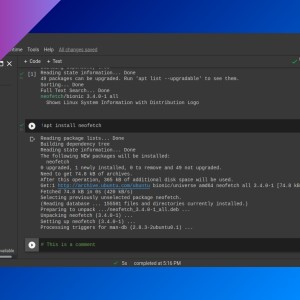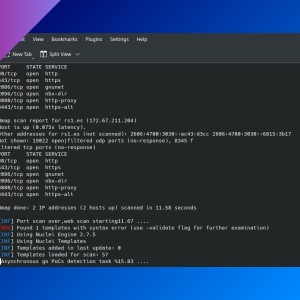awk, sed, cut and tr: processing a text file
Table of Contents
When you want to process a text file using the command line, awk, sed, cut and tr are the most used programs. Here you will learn the basic use of each one.
awk
This powerful tool can do simple and complex text processing tasks. It searches for a pattern on a file and performs some actions. This process of searching and performing actions is called a ‘program’. When you run awk, you specify an awk ‘program’.
awk 'program' <input files>- When the program is long, it is more covenient to put it on a file and then run it like this:
awk -f programfile <input files>A program consist of one or several ‘rules’. A program must be enclosed between single quotes. A rule consist of a pattern and an action:
pattern { action }You can omit the pattern (everything matches) or the action (prints all the line). You can add several rules separated by newlines or ;.
A basic use of awk is for printing (showing) all contents of a file.
awk '{print}' text.txt
# or
awk '{print $0}' text.txtPipes
- You can pipe the output of another command to awk.
df -h | awk '{print $0}' awk '{print}' < text.txt- To Export the output to a file.
df -h | awk '{print}' > output.txtColumns
- Print first column of a tab-separator file (or command).
df -h | awk '{print $1}'- Print last column
awk '{print $NF}' text.txtNFstands for “Number of Field”.- Print several columns.
df -h | awk '{print $1,$3}'- Using a diferent separator.
awk -F ":" '{print $1}' /etc/passwd- You can also type
BEGIN {FS=":"}:
awk 'BEGIN {FS=":"}; {print $1}' /etc/passwd- You can add several code blocks inside the single quotes (
awk '{code block}; {code block}')
Rows
- Print a specific line
awk 'NR==3 {print}' text.txtNRstands for “Number of Record”.
Formating the output
- Sum column values row by row (same for other mathematical operations).
$ awk -F ':' '{print $3+$4}' /etc/passwd
0
2
4- Separate column values by some character (like a tab).
$ awk -F ',' '{print NR"\t"$1"\t"$2}' < test.csv
1 fechalectura lectura
2 2021-06-04 177
3 2021-08-10 184
4 2021-10-07 190- Print the total number of lines (records).
# END: this code block runs when all input has been processed
awk -F ':' 'END {print NR}' /etc/passwd- Using
printf.
# Print second column as a floating number with two decimals
awk -F ',' '{printf "%.2f\n",$2}' < testfile- Define the
OFS(Output Field Separator).
awk -F ',' '{OFS="\t"; $1=$1; print}' < test.csvConditions
- Search for a RegExp.
# look for 'sshd'
awk -F ':' '/sshd/ {print $1,$7}' /etc/passwd- Standard “if” (always inside ‘action’ section).
# Don't print first value of column 2
awk -F ',' '{if (NR != 1) print $2}' test.csv # Split the file based on the third column value
awk -F ',' '{if ($3 >= 1000) print $0}' < test.csv > testmore1000.csv
awk -F ',' '{if ($3 < 1000) print $0}' < test.csv > testless1000.csv- Condition outside curly braces.
# Print odd lines
awk 'NR % 2 != 0 {print}' file # Print lines where $1 contains 'a'
awk '$1 ~ /a/ {print}' urls.txt # Print lines if contains abc AND xyz
awk '/abc/ && /xyz/' fileBuilt-in functions
tolower(<string>),toupper(<string>): change uppercase to lowercase and viceversa.
$ awk '{print tolower($0)}' <<< 'Hello World'
hello worldlength(<string>): show the length of a string.
$ awk '{print length($0)}' <<< 'Hello World'
11mktime(<date spec>): transform a date spec into a timestamp.
$ awk '{print mktime($0)}' <<< '2022 01 01 02 00 00'
1640998800strftime(<format>, <timestamp>): format a timestamp.
$ awk '{print strftime("%d-%m-%Y",$0)}' <<< '1640998800'
01-01-2022substr(<string>, <start>, <length>): return a substring.
Some examples
- Sum values for each year
$ awk -F ',' '/2022/ {sum22 += $2} ; /2021/ {sum21 += $2} END {print "2022: " sum22 ", 2021: " sum21}' file.csv
2022: 627, 2021: 748- Add a new calculated column and new column names
# BEGIN: this will run before file processing
# current, diff and prev are variables
$ awk -F ',' 'BEGIN {print "date,m3,diff"}; {current = $2}; {diff = current - prev}; {prev = $2}; {if (NR != 1) print $1","$2","diff}' ../file.csv | column -s ',' -t
date m3 diff
2021-06-04 177 177
2021-08-10 184 7
2021-10-07 190 6
2021-12-06 197 7- Remove two lines (and add line numbers)
$ awk -F ',' '{if (NR==1 || NR==3) {} else {print NR " "$0}}' test.csv | head -n5
2 2021-07-21 00:00,247
4 2021-07-21 02:00,136
5 2021-07-21 03:00,82
6 2021-07-21 04:00,84
7 2021-07-21 05:00,115- Search multiple patterns (&&)
$ ps aux | awk '/pts/ && /bash/'
ricardo 1521 0.0 0.0 11528 5892 pts/1 Ss abr19 0:00 /bin/bash
ricardo 9482 0.0 0.0 11132 5392 pts/39 Ss+ 12:45 0:00 /bin/bash
ricardo 15174 0.0 0.0 12224 3756 pts/1 S+ 14:02 0:00 awk /pts/ && /bash/ $ awk -F ',' '/2021/ && NR==2 {start21=$2}; /2021/ {end21=$2}; /2022/ {end22=$2}; END {print "2021: "end21-start21"; 2022: "end22-end21}' file.csv
2021: 20; 2022: 17- Display a random line (look at the use of double quotes)
$ awk "NR==$(($RANDOM % `wc -l < urls.txt`))+1 {print}" urls.txt
https://eldiario.es
$ awk "NR==$(($RANDOM % `wc -l < urls.txt`))+1 {print}" urls.txt
https://google.comsed
Use the ‘Streaming EDitor’ to transform a text.
Replace/delete text
- Substitute “word1” for “word2”.
sed 's/word1/word2/' text.txtThis command will not change the file, only show the results. You can export the output to a file with > or use -i to edit the original file (use with caution, it’s always safer to create a new file).
sed 's/word1/word2/' text.txt > newtext.txt sed -i 's/word1/word2/' text.txtAlso, it only changes the first occurence in each line. To change all ocurrences:
sed 's/word1/word2/g' text.txt- Find and replace a word in several files at once:
sed -i 's/word1/word2/g' *.txt- Delete word1.
sed 's/word1//g' text.txt- Delete first character of every line.
sed 's/^.//' text.txt- Delete last character of every line.
sed 's/.$//' text.txt- Replace “o” for “O” only on lines that match a pattern.
sed '/root/s/o/O/g' /etc/passwdDelete lines
- Delete lines matching a pattern.
sed '/root/d' /etc/passwd- You can use RegExp when looking for a pattern. This command will delete any empty line.
sed '/^$/d' test.txt- Depending of the file formatting, you can also use
'/\r/d'or'/^\r$/d'.
Print matched lines
sed -n '/pattern/p' file.txtPrepend/Append lines
- Insert text one line before every line.
sed 'i\new line' test.txt- Append text (insert one line after every line).
sed 'a\new line' test.txtSpecify a line number
If you add a line number before the subcommand letter (a, i, d, etc.) that subcommand will only run in that line. To refer to the last line, type $.
# Delete second line
sed 2d test.txt
# Delete from line 3 to line 6
sed 3,6d test.txt# Insert a line at the beginning
sed '1i\new line' test.txtExtended RegExp support
For some RegExp, you may need to use -E parameter.
sed -E '/(\.com)$/d'Replace between patterns
You can use RegExp to split a line into several groups (using parenthesis) and replace only one of them.
$ cat urls.txt
https://elpais.com
https://eldiario.es
https://radiohuesca.com
https://google.com
$ sed -E 's/^(https:\/\/)(.*)(\.com)$/\1test\3/' urls.txt
https://test.com
https://eldiario.es
https://test.com
https://test.com- You can select pattern groups with
\and its number:1for first group,2for the second, etc. In this case, we want to print the first group (https://), addtestand print the third group (.com).
More examples
- Merge lines 2 and 3. Replace ‘2’ with the line you want to merge. You can add spaces or any character between the lines.
sed '2N;s/\n//' testfile- Change only first occurence in a file (from line 0 to
/-/)
$ cat text
Hola Mundo
-
Hola Mundo
$ sed '0,/-/{s/H/h/g}' text
hola Mundo
-
Hola Mundo- Change uppercase to lowercase and viceversa
sed 's/[[:lower:]]/\U&/g' lowertoupper.txt
sed 's/[[:upper:]]/\l&/g' uppertolower.txt
# Detects accented letterscut
cut is a simpler version of awk. You can use it to separate a text in columns and show a specific column or several columns.
- Print first column on a ”:” delimiter file.
cut -d ":" -f1 /etc/passwd- Print two columns.
cut -d ":" -f1,7 /etc/passwd- By default,
cutuses the delimiter as a separator in the output, but you can change it with--output-delimiter=DELIMITER.
cut -d ":" -f1,7 --output-delimiter=" " /etc/passwdtr
tr works similar to sed: translates or deletes characters from standard input, writing to standard output.
tr 'character' 'substitution' < fileFor example, you can change commas to tabs:
tr ',' '\t' < file.csv- You can achieve something similar with
column -s ',' -t < file.csv.
Or you can delete all spaces:
echo {a..z} | tr -d ' 'You can change uppercase into lowercase (and viceversa) easily:
$ tr '[:lower:]' '[:upper:]' <<< 'Hello World'
HELLO WORLDIf you have any suggestion, feel free to contact me via social media or email.
Latest tutorials and articles:
Featured content:











